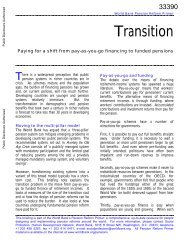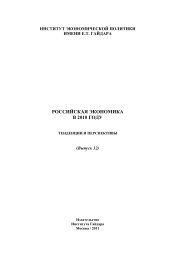Financial Sector Development in Africa: Opportunities ... - World Bank
Financial Sector Development in Africa: Opportunities ... - World Bank
Financial Sector Development in Africa: Opportunities ... - World Bank
You also want an ePaper? Increase the reach of your titles
YUMPU automatically turns print PDFs into web optimized ePapers that Google loves.
2 Beck and Maimbo<br />
to the bottom of the pyramid. Notwithstand<strong>in</strong>g this approach, however,<br />
we recognize that microf<strong>in</strong>ance <strong>in</strong>stitutions will cont<strong>in</strong>ue to play a<br />
decisive role <strong>in</strong> the expand<strong>in</strong>g access agenda <strong>in</strong> the com<strong>in</strong>g years.<br />
In chapter 1, Alexandra Jarotschk<strong>in</strong> gauges the current state of microf<strong>in</strong>ance<br />
<strong>in</strong>stitutions (MFIs) across <strong>Africa</strong>, both <strong>in</strong> comparison with other<br />
regions of the world and with<strong>in</strong> different subregions <strong>in</strong> <strong>Africa</strong>. She documents<br />
the limited outreach of <strong>Africa</strong>n MFIs <strong>in</strong>to rural areas and the slowdown<br />
<strong>in</strong> their expansion <strong>in</strong> the wake of the global f<strong>in</strong>ancial crisis. She<br />
then discusses several challenges that microf<strong>in</strong>ance <strong>in</strong> <strong>Africa</strong> must confront,<br />
<strong>in</strong>clud<strong>in</strong>g cost constra<strong>in</strong>ts, deficiencies <strong>in</strong> understand<strong>in</strong>g clients’<br />
needs, absent or <strong>in</strong>efficient prudential and nonprudential regulation, and<br />
the lack of f<strong>in</strong>ancial <strong>in</strong>frastructure.<br />
Technology can be a game changer <strong>in</strong> the economics of retail bank<strong>in</strong>g.<br />
This is especially important <strong>in</strong> <strong>Africa</strong>, where f<strong>in</strong>ancial systems face high<br />
barriers to further outreach, <strong>in</strong>clud<strong>in</strong>g high transaction costs. David<br />
Porteous focuses <strong>in</strong> chapter 2 on one specific aspect: mobile f<strong>in</strong>ancial<br />
services. In the past decade, <strong>Africa</strong> has <strong>in</strong>cubated some of the earliest<br />
deployments of mobile payment services and now hosts some of its most<br />
successful providers. Porteous’s chapter characterizes the development of<br />
mobile f<strong>in</strong>ancial services across several models. He predicts the rise of a<br />
new model that is based on mobile Internet and can thus help overcome<br />
market segmentation and monopoly barriers, with a truly transformative<br />
impact on expand<strong>in</strong>g access to f<strong>in</strong>ance <strong>in</strong> <strong>Africa</strong>. While the first generation<br />
of mobile payment services provided only an additional delivery<br />
channel for exist<strong>in</strong>g customers, second-generation models—such as<br />
Celpay <strong>in</strong> Zambia and M-Pesa <strong>in</strong> Kenya—reached out to new, previously<br />
unbanked clientele. The fragmented nature of the mobile phone market<br />
<strong>in</strong> many <strong>Africa</strong>n countries, the lack of <strong>in</strong>terconnectedness of mobile<br />
phone providers, and the dependence of the second-generation model on<br />
mobile phone companies, however, limit the growth of mobile f<strong>in</strong>ancial<br />
services. Porteous po<strong>in</strong>ts to the promise of third-generation, mobile<br />
Internet-driven models that will enable a whole new range of providers<br />
to offer payment services to the public. F<strong>in</strong>ally, a host of regulatory and<br />
competition issues arise from the rapid expansion and development of<br />
mobile f<strong>in</strong>ancial services.<br />
One sector where expand<strong>in</strong>g access is especially challeng<strong>in</strong>g is<br />
agricultural f<strong>in</strong>ance. In chapter 3, Mike Coates and Rob<strong>in</strong> Hoffmeister<br />
describe the many challenges that f<strong>in</strong>anc<strong>in</strong>g agriculture <strong>in</strong> <strong>Africa</strong> poses,<br />
but they also describe possible solutions. The barriers to f<strong>in</strong>ancial<br />
broaden<strong>in</strong>g—high costs, high volatility, high <strong>in</strong>formality, and governance







